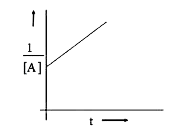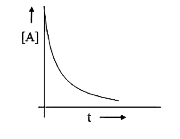Which of the following curve represent zero order reaction of A→ products ?




The correct Answer is:D
To determine which curve represents a zero-order reaction for the reaction A→products, we can follow these steps:
Step 1: Understand Zero-Order Reactions
In a zero-order reaction, the rate of reaction is constant and does not depend on the concentration of the reactant. The rate law can be expressed as:
R=k
where R is the rate of reaction and k is the rate constant.
Step 2: Derive the Concentration Equation
For a zero-order reaction, the change in concentration of A over time can be described by the equation:
(A)=(A0)−kt
where:
- (A) is the concentration of A at time t,
- (A0) is the initial concentration of A,
- k is the rate constant,
- t is time.
Step 3: Identify the Graph Characteristics
The equation (A)=(A0)−kt can be rearranged to resemble the equation of a straight line:
y=mx+c
where:
- y is (A),
- m (the slope) is −k (which is negative),
- x is t,
- c (the y-intercept) is (A0).
Step 4: Analyze the Graph
From the characteristics of the graph:
- The graph of a zero-order reaction will be a straight line with a negative slope.
- The y-intercept of the graph will be equal to the initial concentration (A0).
Step 5: Choose the Correct Curve
Given the options, we need to find the graph that:
- Is a straight line,
- Has a negative slope,
- Intersects the y-axis at (A0).
After analyzing the provided curves, the correct curve that represents a zero-order reaction is the one that meets all these criteria.
Final Answer
The correct curve representing a zero-order reaction of A→products is option D.
---
In a zero-order reaction, the rate of reaction is constant and does not depend on the concentration of the reactant. The rate law can be expressed as:
R=k
where R is the rate of reaction and k is the rate constant.
For a zero-order reaction, the change in concentration of A over time can be described by the equation:
(A)=(A0)−kt
where:
- (A) is the concentration of A at time t,
- (A0) is the initial concentration of A,
- k is the rate constant,
- t is time.
The equation (A)=(A0)−kt can be rearranged to resemble the equation of a straight line:
y=mx+c
where:
- y is (A),
- m (the slope) is −k (which is negative),
- x is t,
- c (the y-intercept) is (A0).
From the characteristics of the graph:
- The graph of a zero-order reaction will be a straight line with a negative slope.
- The y-intercept of the graph will be equal to the initial concentration (A0).
Given the options, we need to find the graph that:
- Is a straight line,
- Has a negative slope,
- Intersects the y-axis at (A0).
The correct curve representing a zero-order reaction of A→products is option D.
Topper's Solved these Questions
- CHEMICAL KINETICSBook:A2ZChapter:CHEMICAL KINETICSExercise:Initial Rate Method And Ostwaid Method
Explore 18 Videos
- CHEMICAL KINETICSBook:A2ZChapter:CHEMICAL KINETICSExercise:Arrhenius Equation, Effect Of Temprature And Effect Of Catalysts
Explore 35 Videos
- CHEMICAL KINETICSBook:A2ZChapter:CHEMICAL KINETICSExercise:Rate Law, Law Of Mass Action, Order Of The Reaction, And Molecularity
Explore 48 Videos
- BIOMOLECULESBook:A2ZChapter:BIOMOLECULESExercise:Section D - Chapter End Test
Explore 30 Videos
- COORDINATION COMPOUNDSBook:A2ZChapter:COORDINATION COMPOUNDSExercise:Section D - Chapter End Test
Explore 30 Videos
Similar Questions
Knowledge Check
Which of the following curve represent zero order reaction of A→ products ?
A B
B C
C D
D
Which of the following represents zero order reaction ?
A B
B C
C D
D
Which of the following curves represent(s) a zero-order reaction?
A B
B C
C D
D
Which of the following curves represents a first order reaction.
View SolutionWhich of the following curves represents a third order reaction ?
View SolutionWhich of the following curves represents a second order reaction ? [x = product oncentration (a−x) = reactant concentration)
View SolutionWhich of the following curves represents a zero order reaction ? [(a−x) =reactant concn.]
View SolutionWhich of the following graphs represents a first order reaction ?
View Solution

